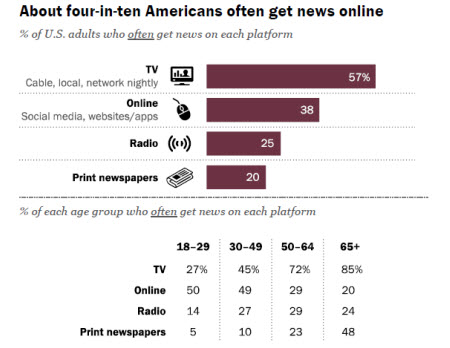Pew: Majority of Consumers Say News Is Biased

Consumers show a clear preference for getting news on a screen, and the TV screen still leads the way, though signs of a big generational shift are emerging.
Moreover, a majority of consumers believe news outlets are biased when covering political and social issues, according to a new survey from the Pew Research Center.
The survey found that 57% of all news consumers "often" get news from cable or broadcast TV networks and local stations. Among those, local TV news remains the top draw, at 46%, followed by cable networks at 31% and broadcast network news at 30%.
Second after TV, 38% of respondents said they often get news from social media or websites/apps. Radio followed, cited by 25% of respondents, with newspapers trailing the pack at 20%.
When respondents' age is factored in, however, the screen preferences start moving online.
While 72% of those 50-64 often get news on TV, only 27% of 18-29 year-olds said they often get news from TV. By contrast, 50% of 18-29s said they often get news online, while that figure was only 29% among 50-64 year-olds.
Print is in the most precarious position, the study suggests, since those who prefer to watch news still favor TV over online, while those who prefer to read it are migrating to reading it on a screen, and increasingly on a mobile screen.
The smarter way to stay on top of the multichannel video marketplace. Sign up below.
News consumers are skeptical of they outlets the frequent.
Only about two in 10 respondents said they have "a lot" of trust in the information they get, with social media the least trusted, at only 4%.
As to how that information is being presented, only 24% said that news organizations covering political and social issues "deal fairly with all sides," while 74% said news outlets "tend to favor one side."
The study found that while 54% of news consumers got at least some news on a mobile device in 2013, that number is now 72%.
The study was conducted in two parts. The first survey was conducted Jan. 12-Feb. 8, 2016, among 4,654 U.S. adults 18-plus who are members of Pew Research Center’s American Trends Panel. The second part comprised 14 online surveys Feb. 24-March 1, 2016, with 2,078 panelists participating, answering at least 10 of the 14 surveys.
Contributing editor John Eggerton has been an editor and/or writer on media regulation, legislation and policy for over four decades, including covering the FCC, FTC, Congress, the major media trade associations, and the federal courts. In addition to Multichannel News and Broadcasting + Cable, his work has appeared in Radio World, TV Technology, TV Fax, This Week in Consumer Electronics, Variety and the Encyclopedia Britannica.

